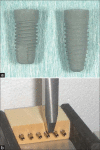Evaluation of Primary Stability of Cylindrical and Tapered Implants in Different Bone Types by Measuring Implant Displacement: An In vitro Study
- PMID: 32308322
- PMCID: PMC7150554
- DOI: 10.4103/ccd.ccd_788_18
Evaluation of Primary Stability of Cylindrical and Tapered Implants in Different Bone Types by Measuring Implant Displacement: An In vitro Study
Abstract
Aims: The purposes of this study were to investigate the primary stability of cylindrical and tapered implants in different bone types by measuring implant displacement and to examine the relationship between insertion torque value (ITV) and implant displacement.
Materials and methods: Four different polyurethane bone models consisted of low-density or low-to-medium-density cancellous bone with or without a cortical bone layer. A total of 120 cylindrical and tapered implants were placed into bone blocks (n = 15 in each group), and the ITV was measured. A lateral load of 15 N was applied to the top of the abutment, and implant displacement was recorded.
Results: Implant displacement was significantly affected by cancellous bone density and to a lesser degree by cortical bone thickness. The displacement of tapered implants was significantly smaller than that of cylindrical implants in the presence of cortical bone. However, both implant groups showed similar ITV in the low-density cancellous bone model with the cortical bone layer. There was a correlation between ITV and displacement in the cylindrical and tapered implants. However, no correlation was observed between ITV and displacement within each bone type.
Conclusions: Implant stability depended mainly on the bone type, whereas implant design had a limited influence on primary stability. The use of tapered implants may be advantageous for improving primary stability in patients with low-density cancellous bone only when crestal cortical bone exists. The same ITV of cylindrical and tapered implants did not necessarily represent similar primary stability in the bone type.
Keywords: Bone density; dental implants; torque.
Copyright: © 2020 Contemporary Clinical Dentistry.
Conflict of interest statement
There are no conflicts of interest.
Figures



References
-
- Brunski JB, Puleo DA, Nanci A. Biomaterials and biomechanics of oral and maxillofacial implants: Current status and future developments. Int J Oral Maxillofac Implants. 2000;15:15–46. - PubMed
-
- Szmukler-Moncler S, Salama H, Reingewirtz Y, Dubruille JH. Timing of loading and effect of micromotion on bone-dental implant interface: Review of experimental literature. J Biomed Mater Res. 1998;43:192–203. - PubMed
-
- Bardyn T, Gédet P, Hallermann W, Büchler P. Quantifying the influence of bone density and thickness on resonance frequency analysis: An in vitro study of biomechanical test materials. Int J Oral Maxillofac Implants. 2009;24:1006–14. - PubMed
-
- Tabassum A, Meijer GJ, Wolke JG, Jansen JA. Influence of surgical technique and surface roughness on the primary stability of an implant in artificial bone with different cortical thickness: A laboratory study. Clin Oral Implants Res. 2010;21:213–20. - PubMed
-
- Morton D, Jaffin R, Weber HP. Immediate restoration and loading of dental implants: Clinical considerations and protocols. Int J Oral Maxillofac Implants. 2004;19(Suppl):103–8. - PubMed
LinkOut - more resources
Full Text Sources
